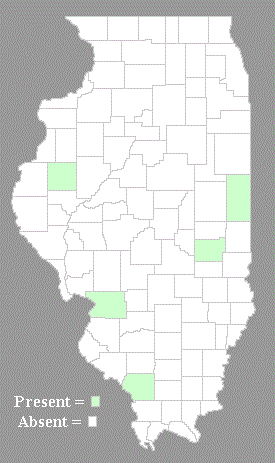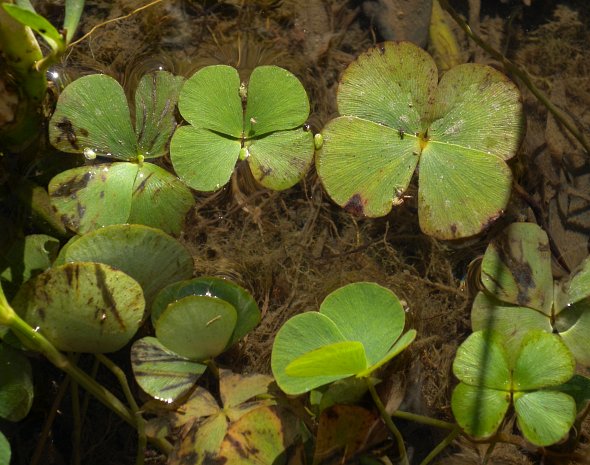
Near the bases of petioles, there are sporocarps (spore-bearing bodies) on short peduncles up to 12 mm. (½") long. These sporocarps are typically arranged on branched peduncles in groups of 2-3, although there can be only a single sporocarp to as many as 5 sporocarps per peduncle. The bases of these peduncles are attached 1-20 mm. above the bases of petioles. Individual sporocarps are about 3.5-5.0 mm. long, 3.0-3.5 mm. across, and 2.0-2.5 mm. thick; they are ovoid and somewhat flattened in shape with rounded ends and slightly convex sides. The sporocarps are reddish brown, dark brown, or dark purple; young sporocarps are yellow-hairy, while older sporocarps are glabrous. The interior of each sporocarp is divided into several chambers (or sori); these chambers contain both macrospores and microspores that are self-compatible. The root system consists of long slender rhizomes that produce basal leaves at their nodes; the internodes of these rhizomes (distance
 between adjacent nodes) are up to 4" long. Fine fibrous roots are
produced primarily at the nodes and, to a lesser extent, along the
internodes.
between adjacent nodes) are up to 4" long. Fine fibrous roots are
produced primarily at the nodes and, to a lesser extent, along the
internodes.Cultivation: The preference is full or partial sun, and shallow water up to 1' deep or wet muddy ground. Aquatic plants will adapt to either stagnant or slow-moving water. This fern can be planted outdoors, where it is winter-hardy to Zone 5; it will also adapt to indoor aquariums. In North America, this fern may invade shallow wetlands in some areas, where it can displace native plants. The sporocarps (spore-bearing bodies) of this fern may remain dormant for decades. However, once the sporocarps split open to release their spores, development of new plants proceeds quickly.
Range & Habitat: European Water Clover is uncommon in Illinois. It was introduced into North America from the Mediterranean area of Europe during the 19th century as an ornamental aquatic plant. At the present time, this unusual fern is found in several northeastern and Midwestern states of the United States. Habitats include shallow areas of lakes, ponds, and slow-moving creeks. These wetland habitats are often degraded by urban development, intake from storm sewers, boating, or other recreational activities. While this non-native species is not widespread in Illinois at the present time, it is considered potentially invasive.
Faunal Associations: Very little is known about the floral-faunal relationships of this fern in North America. According to Hottes & Frison (1931), this fern is one of the summer hosts of a polyphagous aphid, Myzus persicae (Green Peach Aphid). The leathery sporocarps (spore-bearing bodies) of this fern are a source of food for waterfowl, and the foliage has been browsed by pigs and cattle in Europe. This fern has been spread to new areas primarily by human activities. This involves such activities as leaves with sporocarps clinging to recreational boats or their trailers, careless disposal of aquarium plants into bodies of water or storm sewers, escape from water gardens as a result of flooded conditions, and people deliberately introducing this fern into natural areas because they think it is a desirable ornamental plant. This fern may also be transported by waterfowl into new wetlands.
Photographic Location: Shallow water of a pond near a boat ramp in Vermilion County, Illinois.

Comments: European Water Clover (Marsilea quadrifolia) superficially resembles a wood sorrel (Oxalis) or a clover (Trifolium), but it is a spore-producing fern, rather than a flowering seed plant. Wood sorrel and clover can be distinguished by their trifoliate leaves and terrestrial habits, while European Water Clover has quadrifoliate leaves and it is primarily aquatic. While some water clover species (Marsilea spp.) are native to North America, none of them have been found in Illinois; they occur primarily in western North America. One native North American species, Hairy Water Clover (Marsilea vestita), can be found in some central states (e.g., Kansas & western Iowa). It is similar in appearance to European Water Clover, but its foliage (leaflets & petioles) tends to be more hairy. Hairy Water Clover also differs by having unbranched sporocarp peduncles; the bases of these peduncles are attached no higher than 3 mm. (1/8") from the bases of leaf petioles.